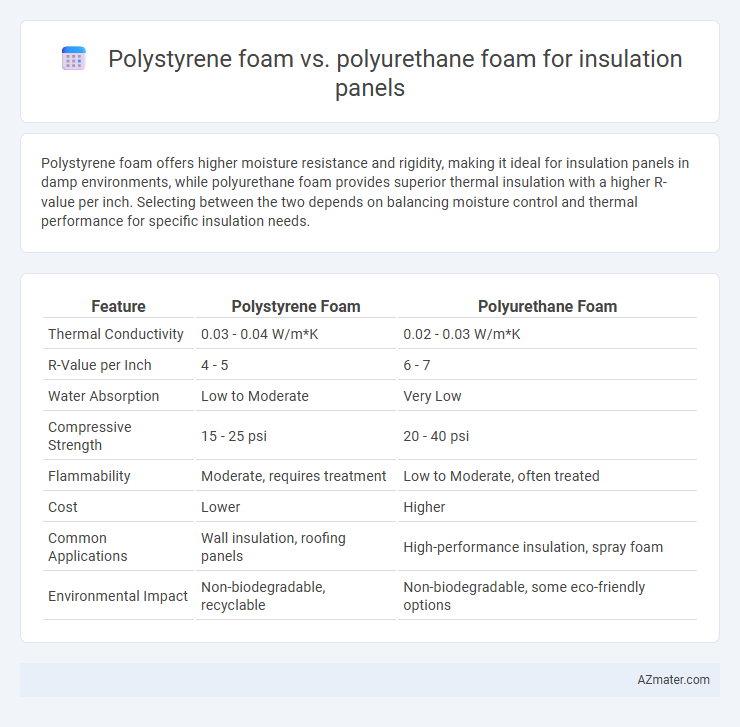Polystyrene foam offers higher moisture resistance and rigidity, making it ideal for insulation panels in damp environments, while polyurethane foam provides superior thermal insulation with a higher R-value per inch. Selecting between the two depends on balancing moisture control and thermal performance for specific insulation needs.
Table of Comparison
| Feature | Polystyrene Foam | Polyurethane Foam |
|---|---|---|
| Thermal Conductivity | 0.03 - 0.04 W/m*K | 0.02 - 0.03 W/m*K |
| R-Value per Inch | 4 - 5 | 6 - 7 |
| Water Absorption | Low to Moderate | Very Low |
| Compressive Strength | 15 - 25 psi | 20 - 40 psi |
| Flammability | Moderate, requires treatment | Low to Moderate, often treated |
| Cost | Lower | Higher |
| Common Applications | Wall insulation, roofing panels | High-performance insulation, spray foam |
| Environmental Impact | Non-biodegradable, recyclable | Non-biodegradable, some eco-friendly options |
Overview of Polystyrene Foam and Polyurethane Foam
Polystyrene foam, including expanded (EPS) and extruded (XPS) types, offers excellent thermal insulation with a closed-cell structure that provides moisture resistance and high compressive strength, commonly used in insulation panels for walls and roofs. Polyurethane foam features a higher R-value per inch due to its rigid, closed-cell composition, delivering superior thermal performance and airtightness ideal for insulation panels in energy-efficient buildings. Both foams are lightweight, durable, and widely used in construction, with polystyrene known for cost-effectiveness and moisture resistance, while polyurethane excels in thermal resistance and flexibility.
Material Composition and Manufacturing Process
Polystyrene foam insulation panels are primarily composed of expanded or extruded polystyrene beads that provide rigid, closed-cell structure with high thermal resistance, produced through a process involving polymerization, bead expansion, and molding. Polyurethane foam panels consist of a polymer formed by the reaction of polyols and diisocyanates, resulting in a flexible or rigid cellular structure created through a chemical foaming process that allows for tailored density and insulation properties. The manufacturing of polystyrene foam emphasizes physical expansion and shaping, whereas polyurethane foam combines chemical reactions and blowing agents for enhanced versatility and superior insulation performance.
Thermal Insulation Performance Comparison
Polystyrene foam insulation panels exhibit a thermal conductivity ranging from 0.030 to 0.040 W/m*K, providing efficient resistance to heat transfer in many construction applications. Polyurethane foam insulation panels typically demonstrate lower thermal conductivity values between 0.020 and 0.025 W/m*K, offering superior insulation performance and higher R-values per inch of thickness. This enhanced thermal insulation capability makes polyurethane foam panels preferable for applications demanding maximum energy efficiency and thermal resistance.
Moisture Resistance and Water Absorption
Polystyrene foam offers superior moisture resistance with low water absorption rates, making it ideal for insulation panels in damp environments. Polyurethane foam, while providing excellent thermal insulation, tends to absorb more water, which can compromise its insulating properties over time. Choosing polystyrene foam ensures enhanced durability and consistent performance in moisture-prone applications.
Fire Resistance and Safety Ratings
Polystyrene foam insulation panels typically have lower fire resistance, with a flame spread rating around 75-100, making them more prone to ignition and producing toxic smoke during combustion. Polyurethane foam exhibits better fire resistance and safety ratings, often equipped with fire retardants that limit flame spread to below 25 and reduce smoke generation. Building codes often favor polyurethane foam for insulation panels in fire-sensitive applications due to its superior performance in meeting stringent fire safety standards.
Mechanical Strength and Durability
Polystyrene foam offers moderate mechanical strength suitable for lightweight insulation panels, with high compressive resistance but limited impact durability compared to polyurethane foam. Polyurethane foam exhibits superior mechanical strength due to its higher density and cellular structure, providing enhanced resistance to deformation and prolonged durability under load. Both materials resist moisture and chemical degradation, yet polyurethane foam generally outperforms polystyrene in maintaining structural integrity across varying environmental conditions.
Environmental Impact and Sustainability
Polystyrene foam insulation panels, often made from non-biodegradable petroleum-based materials, pose challenges in recycling and contribute to long-term landfill waste, impacting environmental sustainability negatively. Polyurethane foam, while also petroleum-derived, offers options for incorporating bio-based polyols that can reduce carbon footprint and improve its environmental profile. Both foams emit greenhouse gases during production, but advancements in formulation and recycling processes are progressively enhancing their sustainability in insulation applications.
Cost Considerations and Market Availability
Polystyrene foam insulation panels generally offer lower upfront costs due to simpler manufacturing processes and widespread commercial production, making them attractive for large-scale, budget-sensitive projects. Polyurethane foam panels, while more expensive, provide superior thermal resistance (R-value) per inch, potentially reducing long-term energy expenses despite higher initial investment. Market availability favors polystyrene foam with extensive distribution in retail and construction sectors, whereas polyurethane foam panels are specialized products often supplied through niche channels and contractors.
Ease of Installation and Handling
Polystyrene foam insulation panels are lightweight and rigid, making them easy to cut and handle on-site, which reduces labor time and effort during installation. Polyurethane foam panels, while offering superior thermal performance, tend to be denser and more flexible, requiring careful handling to avoid damage and specialized tools for precise fitting. Both materials provide effective insulation, but polystyrene's straightforward installation process often makes it preferred for DIY projects and quick renovations.
Best Applications for Each Foam Type
Polystyrene foam excels in insulation panels for exterior walls, roofing, and foundation applications due to its high moisture resistance, rigid structure, and cost-effectiveness. Polyurethane foam offers superior thermal insulation with a higher R-value per inch, making it ideal for interior applications such as wall cavities, ceilings, and HVAC duct insulation where space-saving and enhanced energy efficiency are critical. Both foam types serve distinct roles, with polystyrene better suited for moisture-prone environments and polyurethane preferred for optimal thermal performance in confined spaces.

Infographic: Polystyrene foam vs Polyurethane foam for Insulation panel
 azmater.com
azmater.com